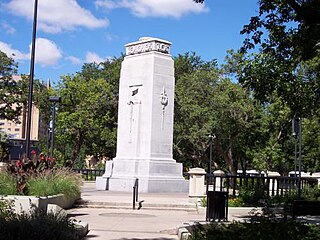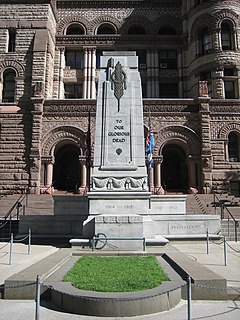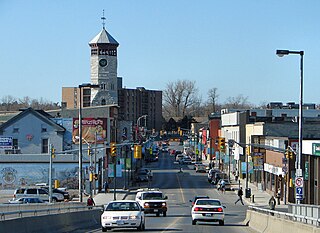
Remembrance Day is a memorial day observed in Commonwealth member states since the end of the First World War to remember the members of their armed forces who have died in the line of duty. Following a tradition inaugurated by King George V in 1919, the day is also marked by war remembrances in many non-Commonwealth countries. Remembrance Day is observed on 11 November in most countries to recall the end of hostilities of First World War on that date in 1918. Hostilities formally ended "at the 11th hour of the 11th day of the 11th month", in accordance with the armistice signed by representatives of Germany and the Entente between 5:12 and 5:20 that morning. The First World War officially ended with the signing of the Treaty of Versailles on 28 June 1919.

A war memorial is a building, monument, statue or other edifice to celebrate a war or victory, or to commemorate those who died or were injured in a war.

The National Monument is a sculpture that commemorates those who died in Malaysia's struggle for freedom, principally against the Japanese occupation during World War II and the Malayan Emergency, which lasted from 1948 until 1960. It is located in the Federal capital, Kuala Lumpur. The Malaysian Houses of Parliament are situated near the monument.

The National War Memorial is a tall, granite memorial arch with accreted bronze sculptures in Ottawa, Ontario, Canada, designed by Vernon March and first dedicated by King George VI in 1939. Originally built to commemorate the Canadians who died in the First World War, it was in 1982 rededicated to also include those killed in the Second World War and Korean War and again in 2014 to add the dead from the Second Boer War and War in Afghanistan, as well as all Canadians killed in all conflicts past and future. It now serves as the pre-eminent war memorial of 76 cenotaphs in Canada. In 2000, the Tomb of the Unknown Soldier was added in front of the memorial and symbolizes the sacrifices made by all Canadians who have died or may yet die for their country.

The Cenotaph, in Regina, Saskatchewan, was built in honour Regina's fallen heroes of World War I.

The Old City Hall Cenotaph is a cenotaph located at the front steps of Old City Hall in Toronto, Ontario, Canada.

The Beatty Street Drill Hall is a Canadian Forces armoury located at 620 Beatty Street in Vancouver, British Columbia. It is the home of The British Columbia Regiment, an armoured reconnaissance reserve regiment, the oldest military unit in Vancouver, and the most senior militia in the province.

Canadian war memorials are buildings, monuments, and statues that commemorate the armed actions in the territory encompassing modern Canada, the role of the Canadian military in conflicts and peacekeeping operations, and Canadians who died or were injured in a war. Much of this military history of Canada is commemorated today with memorials across the country and around the world. Canadian memorials commemorate the sacrifices made as early as the Seven Years' War to the modern day War on Terror. As Newfoundland was a British Dominion until joining Confederation in 1949, there are several monuments in Newfoundland and Labrador and abroad which were dedicated to Newfoundland servicemen and women.

The Preston Cenotaph stands in Market Square, Preston, Lancashire, England, and is a monument to soldiers from Preston who perished in World War I and II. Unveiled on 13 June 1926, the memorial was designed by Sir Giles Gilbert Scott with sculptural work by Henry Alfred Pegram.

Southampton Cenotaph is a First World War memorial designed by Sir Edwin Lutyens and located in Watts Park in Southampton, southern England. The memorial was the first of dozens by Lutyens to be built in permanent form and it influenced his later designs, including The Cenotaph on Whitehall in London. It is a tapering, multi-tiered pylon which culminates in a series of diminishing layers before terminating in a sarcophagus which features a recumbent figure of a soldier. In front is an altar-like Stone of Remembrance. The cenotaph contains multiple sculptural details including a prominent cross, the town's coat of arms, and two lions. The names of the dead are inscribed on three sides. Although similar in outline, Lutyens' later cenotaphs were much more austere and featured almost no sculpture. The design uses abstract, ecumenical features and lifts the recumbent soldier high above eye level, anonymising him.

Rochdale Cenotaph is a First World War memorial on the Esplanade in Rochdale, Greater Manchester, in the north west of England. Designed by Sir Edwin Lutyens, it is one of seven memorials in England based on his Cenotaph on Whitehall in London and one of his more ambitious designs. The memorial was unveiled in 1922 and consists of a raised platform bearing Lutyens' characteristic Stone of Remembrance next to a 10-metre (33 ft) pylon topped by an effigy of a recumbent soldier. A set of painted stone flags surrounds the pylon.

The Middlesbrough Cenotaph is a war memorial situated in Middlesbrough, North Yorkshire, England. It is located just off Linthorpe Road outside the entrance gates to Albert Park in front of the Dorman Museum. It commemorates the local men who lost their lives in the First and Second World Wars and other conflicts.

HMCS Trentonian was a modified Flower-class corvette that served with the Royal Canadian Navy during the Second World War. She fought primarily in the Battle of the Atlantic and the English Channel as a convoy escort. She was named for Trenton, Ontario, though due to a naming conflict with another vessel, her name was changed. She was sunk in 1945.

Lewes War Memorial is a war memorial at the top of School Hill in the centre of Lewes in East Sussex, prominently sited at the junction of High Street and Market Street. It commemorates 251 men from Lewes who died in the First World War, and 126 who died in the Second World War. It was unveiled in 1922 and became a listed building in 1985.
There are 20 Grade I listed war memorials in England, out of over 3,000 listed war memorials. In the United Kingdom, a listed building is a building or structure of special historical or architectural importance; listing offers the building legal protection against demolition or modification, which requires permission from the local planning authority. Listed buildings are divided into three categories—grade I, grade II*, and grade II—which reflect the relative significance of the structure and may be a factor in planning decisions. Grade II accounts for 92% of listed buildings, while grade II* is an intermediate grade accounting for 5.5%; grade I holds the remaining 2.5% of listed buildings and is reserved for structures of exceptional significance. Grade I listed war memorials are deliberately very few, though several have been upgraded to grade I status as part of commemorations around the First World War centenary. A war memorial listed at grade I will be of exceptional interest for its design and artistic merit and will be of great historical interest. Such memorials are often the work of famous architects or sculptors, amongst the most prolific of whom was Sir Edwin Lutyens, whose memorials account for a third of all those listed at grade I. Lutyens designed dozens of war memorials across the United Kingdom and elsewhere in the Commonwealth, including the Cenotaph on Whitehall in London—the focus for the national Remembrance Sunday services—and the Arch of Remembrance in Leicester—the largest of Lutyens' war memorials in Britain; both are listed at grade I. As part of the commemorations of the centenary of the First World War, Historic England—the government body responsible for listing in England—is running a project with the aim of significantly increasing the number of war memorials on the National Heritage List for England.

Southend-on-Sea War Memorial, or Southend War Memorial, is a First World War memorial in Southend-on-Sea, Essex, on the east coast of England. Designed by architect Sir Edwin Lutyens, it is a Grade II* listed building.

The principal war memorial in Enfield Town is the cenotaph that stands in Chase Green Gardens and is a grade II listed monument with Historic England. It commemorates men lost in both the World Wars as does a plaque in the town's main post office. In addition, in 2003 a memorial to those lost in the Arctic campaign of the Second World War was unveiled.

Croydon Cenotaph is a war memorial, in Croydon, London, England. It is located outside Croydon Library, on Katharine Street in Croydon.

Amar Jawan Jyoti is an Indian memorial constructed after the Indo-Pakistani War of 1971 to commemorate the martyred and unknown soldiers of the Indian Armed Forces who died during the war. The memorial was constructed in December 1971 and inaugurated by Indira Gandhi in 1972. Amar Jawan Jyoti is located under India Gate at Rajpath in New Delhi and consists of a marble pedestal on which a cenotaph is situated. "Amar Jawan" is scripted in gold on all four sides of the cenotaph and on top, a L1A1 self-loading rifle stands on its barrel with a helmet of the Unknown Soldier on top. The pedestal is bound by four urns, one of which holds a continuously burning flame.























